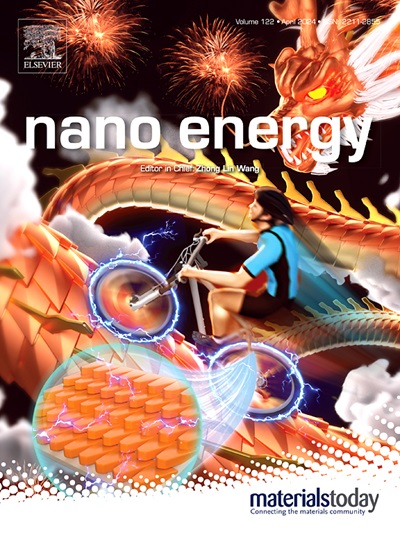能量采集技术对实时功率传感器保持其固有高精度的校准策略
IF 16.8
1区 材料科学
Q1 CHEMISTRY, PHYSICAL
引用次数: 0
摘要
能量收集技术,如摩擦电纳米发电机(TENG),旨在从人体和生活环境中清除高熵能量,为传感器供电,在医疗保健、环境监测和可穿戴传感等领域变得越来越重要。由于生活环境中可收集的能量通常是不规则的,因此在保持其固有的高精度的同时,为广泛分布的传感器供电需要复杂的电源管理和过高的功耗,这使得能量收集技术很难甚至不可能应用于许多场景,例如通常需要实时传感小型化,轻量化和便携性的可穿戴应用。为了克服这一挑战,我们提出了一种校准策略(CS),该策略利用分流电路来监测能量收集的输出并校准传感信号,实现实时高精度传感。我们的理论、计算和实验结果表明,CS使TENG能够作为恒压源,能够实时为各种商用传感器(温度传感器、光传感器和湿度传感器)供电。CS实现的传感相对误差可低至0.87%,这是以前在实时供电传感器中未达到的水平。作为概念验证,我们构建了一个由CS增强型TENG驱动的可穿戴多模态传感系统,能够实时监测人体运动(运动节奏、脚上的力、皮肤表面温度和相对湿度)和环境(光强、温度和相对湿度)。这一发现为能量收集技术提供了一种有效的策略,在保持高精度的同时实时为传感器供电,显著推进了基于能量收集的传感系统的实际应用。本文章由计算机程序翻译,如有差异,请以英文原文为准。

Calibration strategy of energy harvesting technology to real-timely power sensors keeping their inherent high accuracy
Energy harvesting technologies, such as the triboelectric nanogenerator (TENG), which aims to scavenge high-entropy energy from the human body and living environment to power sensors, are becoming increasingly important in fields like healthcare, environmental monitoring, and wearable sensing. Since the collectable energies in living environment are typically irregular, scavenging them to power the widely distributed sensors while maintaining their inherent high accuracy requires complex power management with excessive power consumption, which makes it difficult even impossible for energy harvesting technology to be applied in many scenarios like wearable applications that generally require real-time sensing miniaturization, lightweight, and portability. To conquer this challenge, we proposed a calibration strategy (CS) that utilizes a shunt circuit to monitor the output of energy harvesting and calibrate the sensing signal, achieving real-time high-precision sensing. Our theoretical, computational, and experimental results demonstrate that CS enables TENG to function as a constant voltage source, capable of powering various commercial sensors (temperature sensors, opto-sensors, and humidity sensors) in real time. The sensing relative error achieved by CS can be as low as 0.87%, a level not previously attained in real-time powered sensors. As a proof of concept, we constructed a wearable multi-modal sensing system powered by the CS enhanced TENG, capable of real-time monitoring human motion (movement cadence, force on foot, surface temperature and relative humidity of skin) and environmental (light intensity, temperature, and relative humidity). This finding provides an effective strategy for energy harvesting technology to power sensors in real time while maintaining high accuracy, significantly advancing the practical application of energy-harvesting-based sensing systems.
求助全文
通过发布文献求助,成功后即可免费获取论文全文。
去求助
来源期刊

Nano Energy
CHEMISTRY, PHYSICAL-NANOSCIENCE & NANOTECHNOLOGY
CiteScore
30.30
自引率
7.40%
发文量
1207
审稿时长
23 days
期刊介绍:
Nano Energy is a multidisciplinary, rapid-publication forum of original peer-reviewed contributions on the science and engineering of nanomaterials and nanodevices used in all forms of energy harvesting, conversion, storage, utilization and policy. Through its mixture of articles, reviews, communications, research news, and information on key developments, Nano Energy provides a comprehensive coverage of this exciting and dynamic field which joins nanoscience and nanotechnology with energy science. The journal is relevant to all those who are interested in nanomaterials solutions to the energy problem.
Nano Energy publishes original experimental and theoretical research on all aspects of energy-related research which utilizes nanomaterials and nanotechnology. Manuscripts of four types are considered: review articles which inform readers of the latest research and advances in energy science; rapid communications which feature exciting research breakthroughs in the field; full-length articles which report comprehensive research developments; and news and opinions which comment on topical issues or express views on the developments in related fields.
 求助内容:
求助内容: 应助结果提醒方式:
应助结果提醒方式:


